Physio lab: skeletal muscle, contraction of motor units, contraction of whole muscle IP notes
1/73
There's no tags or description
Looks like no tags are added yet.
Name | Mastery | Learn | Test | Matching | Spaced |
|---|
No study sessions yet.
74 Terms
Skeletal, Cardiac, and Smooth muscle comparison: Skeletal muscle cell
Skeletal Muscle cell: Elongated cells, multiple peripheral nuclei, visible striations, voluntary
Skeletal, Cardiac, and Smooth muscle comparison: Cardiac muscle
Branching cells, single central nucleus, visible striations, involuntary
Skeletal, Cardiac, and Smooth muscle comparison: Smooth muscle cell
Single-shaped cell, single central nucleus, lack visible striations, involuntary
Skeletal, Cardiac, and Smooth muscle comparison: Similar vs. different
Skeletal and Cardiac: Visible striations
Cardiac and Smooth: Single central nucleus, involuntary
What is the main function of skeletal muscles?
Movement of the body

List the three types of contractile cells of the body.
Skeletal muscle cells 2. cardiac muscle cells 3. smooth muscle cells.
Match the following types of contractile cells to their shape (branching, elongated, spindle-shaped):
___________________ a. Skeletal muscle cells
___________________ b. Cardiac muscle cells
___________________ c. Smooth muscle cells
a. elongated b. branching c. spindle-shaped
Match the following types of contractile cells to the characteristics of their nuclei and presence or absence of striations: Cardiac Muscle Cells, Smooth Muscle Cells, Skeletal Muscle Cells
___________________ a. presence of visible striations & single, centrally-located nuclei
___________________ b. presence of visible striations & multiple peripheral nuclei
___________________ c. absence of visible striations & single, centrally-located nuclei number of nuclei
a. Cardiac b. Skeletal c. Smooth
What is the name of the structure that attaches skeletal muscles to bones?
tendons
Bundles of skeletal muscle cells are called
fascicles

The connective tissue which immediately surrounds a muscle is called ________ and the connective tissue around the fascicles is called ________
epimysium 2. perimysium
What is the function of endomysium?
Electricity insulates muscle cells from one another
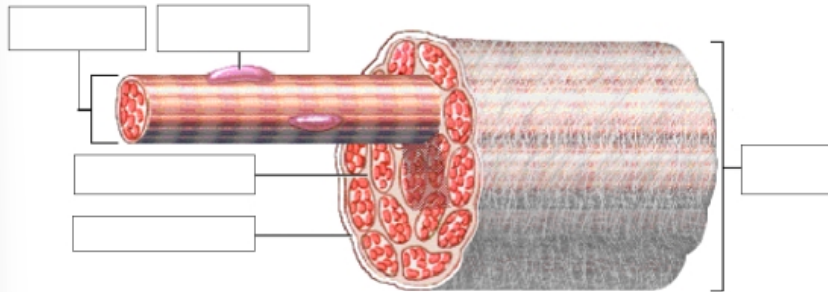
Internal structure of a fascicle - Endomysium: What is it made of? What does it surround?
Made of connective tissue and surrounds individual muscle cells.
What are the general functions of the three connective tissue layers of the muscle (endomysium, perimysium, and epimysium)?
Bind the muscle cells together, provide strength and support to the entire muscle, are continuous with the tendons at the ends of the muscle.
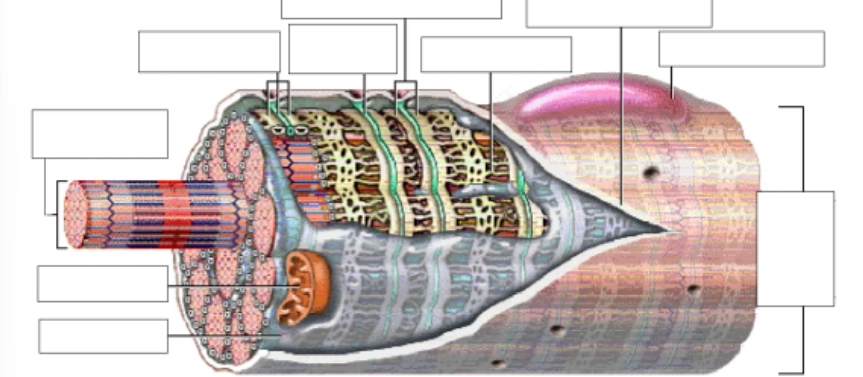
Internal Structure of a Skeletal Muscle Cell: Match these terms to their description:
Triad, T tubules, Terminal cisternae, Sarcolemma, Muscle fibers, Mitochondria, Sarcoplasmic reticulum, Myofibril
___________________ a. Sac-like regions of the sarcoplasmic reticulum that contain calcium ions.
___________________ b. Sites of ATP synthesis.
___________________ c. Plasma membrane of the muscle cell.
___________________ d. Alternative name for skeletal muscle cells.
___________________ e. Interconnecting tubules of endoplasmic reticulum that surround each myofibril.
___________________ f. A group of one T tubule lying between two adjacent terminal cisternae.
___________________ g. Invaginations of the sarcolemma that projecting deep into the cell.
___________________ h. Contains the contractile filaments within the skeletal muscle cell.
a. Terminal cisternae b. Mitochondria c. Sarcolemma d. Muscle fibers e. Sarcoplasmic reticulum (SR) f. Triad g. T tubules h. Myofibril
______ contains genetic material and ______ is intracellular fluid
Nucleus and Cytosol
Contractile units within muscle cells. What are they made of?
Myofibril. Made of myofilaments
What are the names for the two types of myofilament in a myofibril?
Thin filaments and thick filaments
What are thin and thick filaments mainly made of?
Thin: actin. Thick: myosin
What creates the skeletal muscle cell's striated appearance?
The arrangement of thick and thin myofilaments, which form light and dark alternating bands.
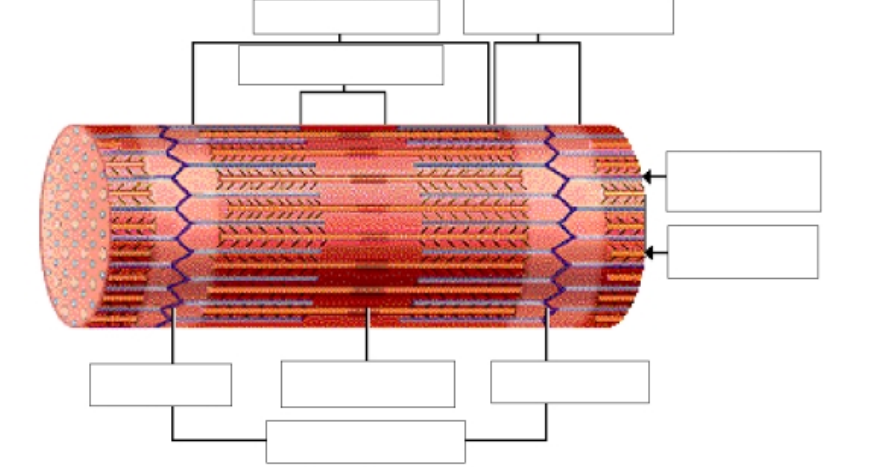
Arrangements of myofilaments. Match the following: A band, H zone, I band, Z line, Sarcomere, M line
a. ______ Dark areas that correspond to the areas where thick filaments are present.
b. ______ Light areas that contains only thin filaments.
c. _______ A protein disk within the I band that anchors the thin filaments and connects adjacent myofibrils.
d. _______Located in the middle of each A band, this lighter stripe appears corresponding to the region between the thin filaments.
e. _______Protein fibers that connect neighboring thick filaments.
f. ________The region of the myofibril between two Z lines.
Keep in mind, this information is crucial for your understanding of the sliding filament theory
a. A bands b. I bands c. Z line d. H zone e. M line f. Sarcomere
Arrangement of myofilaments: Match the following:
A band I band H zone
______________ a. Contains only thin filaments.
______________ b. Contains only thick filaments.
______________ c. Contains both thin and thick filaments
a. I band b. H zone c. A band
Perpendicular to the myofilaments are the Z lines and the M lines. The Z lines connect the _____________ filaments and the M lines connect the _____________ filaments.
Thin, Thick
The region of the myofibril between two Z lines that is the contractile unit of a muscle cell is called a _____________
Sarcomere
Arrange the following from smallest structure to largest structure (bundle-within-a bundle organization of skeletal muscle)
Muscle cell or muscle fiber, Fascicle, Myofilaments, Whole skeletal muscle, Myofibril
myofilaments (actin and myosin) —> myofibril —> muscle cell (muscle fiber) —> fascicle —> whole skeletal muscle
What is a motor unit composed of?
a motor neuron and all of the muscle cells (muscle fibers) it stimulates.
How is the strength of a muscle contraction determined?
by the size and number of motor units being stimulated. The size of the motor unit being stimulated and the number of motor units being stimulated.
What are the groups of muscle cells called, within a muscle, that are innervated by one motor neuron and contracted together and stimulated by that motor neuron?
motor units
What is the junction between the branch of an neuron and a muscle cell called?
a neurovascular junction
When a motor neuron fires, how many muscle cells are stimulated?
When one neuron fires, all the muscle cells which are stimulated by that one neuron will contract. The number of muscle cells in a motor unit can vary from four to several hundred per motor neuron.
What is the average number of motor cells in a motor unit?
150
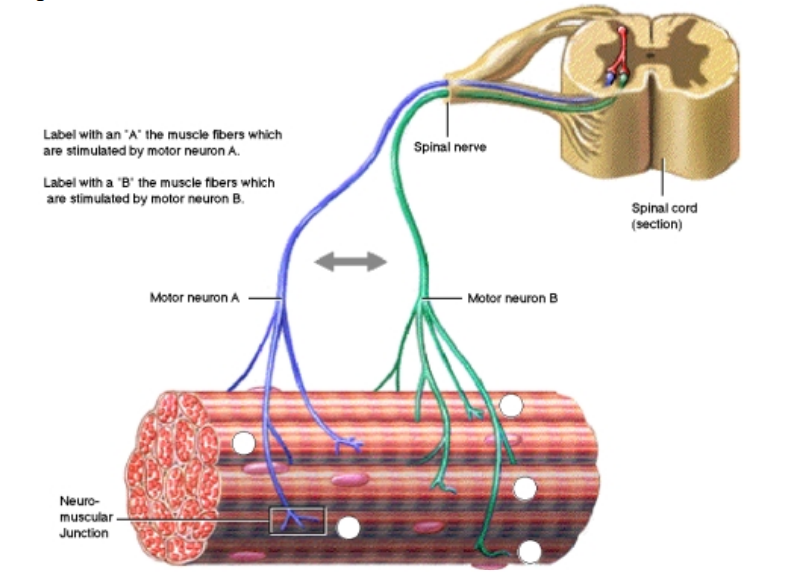
Explain the difference between motor unit A and B
A: stimulates fewer muscle cells. Force of contraction lesser than B. For more precise and accurate movement
B: Bigger motor unit. stimulates more muscle cells. Force of contraction greater than A. For more force of contraction
Both working together will create more force
What is the relationship between the strength of the muscle contraction and the number of motor units which are stimulated?
The stronger the muscle contraction, the more motor units are stimulated (small and large motor units are stimulated to create the most force).
What is recruitment?
The stimulation of additional motor units for increased strength of muscular contraction
Recruitment occurs when…
A strong contraction is needed and additional motor units are stimulated
What is the general function of motor units that contain only a few muscle cells?
Precise muscle movements
Small motor units: What two factors effect the strength and degree of muscle movement?
Number of motor units firing and the number of muscle cells per motor unit. Precise movements are created by small motor units.
Describe the motor units in large muscles which exhibit gross movements
Large muscles which exhibit gross movements have large motor units in which a single neuron is connected to a large number of muscle cells
Tell if the following muscles would have small or large motor units:
a. muscles of the fingers b. biceps brachii muscle c. gastrocnemius muscle d. muscles of the throat involved in speech
Small: a,d Large: b,c
Muscle A contains 12,000 muscle cells and 30 motor neurons which innervate these cells. Muscle B contains 2,000 muscle cells and 400 motor neurons which innervate these cells.
a. On average, how many muscle cells are there in each motor unit for both of these muscles?
b. Which of these muscles would you expect to contract with precise control?
a. A- 400 B- 5
b. Muscle B
What is muscle tone?
Random, minute, asynchronous motor unit contractions which provide a nearly constant state of low-level tension and resistance to stretch in a muscle, even when the muscle is in a relaxed state.
What causes muscle tone?
Nerve impulses are constantly being sent to skeletal muscles.
What happens to a muscle if all the motor neurons to that muscle are cut?
The muscle loses its muscle tone, elongates, and becomes flaccid
T or F: The level of muscle tension that can be developed within a given muscle is always constant.
false
What three factors affect muscle tension in a whole muscle?
Frequency of Stimulation 2. Number of motor units recruited 3. Degree of muscle stretch
A muscle contraction in response to a single stimulus of adequate strength is called a
muscle twitch

What are the three phases of a muscle twitch?
The latent period, contraction phase, and relaxation
Tell if the following are characteristic of the latent period, contraction period or relaxation period of a muscle twitch.
_____________________ a. myosin cross bridge cycling causes sarcomeres to shorten
_____________________ b. cross bridges begin to cycle but no visible shortening of the muscle
_____________________ c. calcium ions are actively transported back into the terminal cisternae
_____________________ d. cross bridge cycling decreases and ends
_____________________ e. the sarcolemma and the T tubules depolarize
_____________________ f. muscle to return to its original length
_____________________ g. calcium ions are released into the cytosol
a. Contraction b. Latent c. Relaxation d. Relaxation e. Latent f. Relaxation g. Latent
What two factors will cause the speed of the contraction phase of a muscle twitch to vary?
The weight of the load being lifted and the type of fibers contracting (slow-twitch fibers or fast-twitch fibers)
What is it called when a second stimulus of the same intensity is applied to a muscle before the completion of the relaxation period of the first stimulus resulting in increased muscle tension?
Temporal summation (wave Summation)
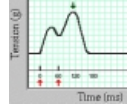
In temporal summation, why is the second peak is higher than the first?
The additional influx of calcium ion promotes a second contraction, which is added to the first contraction

If two stimuli are given to the same muscle, which will result in a more intense second contraction?
a. If the stimuli are given 50 milliseconds apart
b. If the stimuli are given 70 milliseconds apart
a
If you wait until relaxation is complete from the first stimulus, then give a second stimulus to the same muscle, why won't temporal summation occur?
Calcium ions from the first contraction have already been actively transported back into the terminal cisternae. Cross bridge cycling has stopped and there is no activity to be summed.
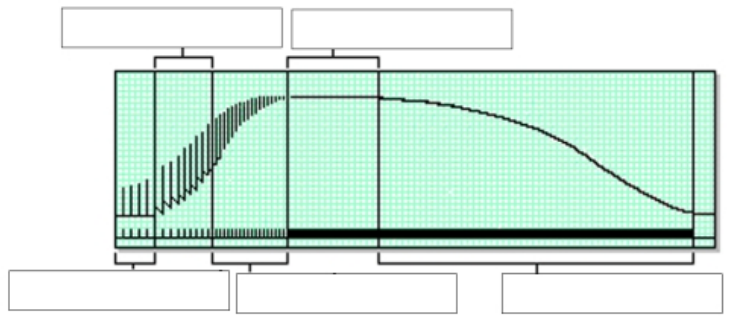
graph of multiple stimuli: Match the state with the definition
Treppe, Temporal Summation, Incomplete tetanus, Complete tetanus, Fatigue
_______a. Now the frequency of stimulation is increased to the point where the muscle exhibits even shorter contraction-relaxation cycles, but there is still some degree of relaxation after each contraction.
_______b. Tetanus cannot continue forever. With continued rapid stimulation, there is a build-up of acidic compounds which affect protein functioning, a relative but not total lack of ATP, and ionic imbalances resulting from membrane activities. This causes muscle fatigue and the gradual inability of the muscle to respond to stimulation.
________c. The frequency of stimulation was so slow here that relaxation was complete between contractions. Note that the curve goes down to the baseline after each contraction
________d. Now the frequency of stimulation is increased to the point where relaxation cannot totally occur.
________e. When the frequency of stimulation becomes fast enough, the contractions fuse into a smooth, continuous, total contraction with no apparent relaxation
a. Incomplete tetanus b. fatigue c. treppe d. temporal summation e. complete tetanus
graph of multiple stimuli: State at which: The strength of contraction did increase because muscle contraction causes heat to build up in the muscles and muscles then work better when they are warmer. Enzymes can work faster and more efficiently when a muscle is "warmed up".
Treppe
graph of multiple stimuli: State at which: The result is a continual increase in tension which may result from increased availability of intracellular calcium.
temporal summation
graph of multiple stimuli: State at which: This state is due to a continual depositing of calcium ions in the cytosol. As a result, the binding sites on actin continually stay exposed.
Complete tetanus
In which of the following states does the muscle stay contracted, with no apparent relaxation?
a. temporal summation b. fatigue c. incomplete tetanus d. treppe e. complete tetanus
e
In which of the following states does the muscle relax totally between stimulations?
a. temporal summation b. fatigue c. incomplete tetanus d. treppe e. complete tetanus
d
In which of the following states does the strength of contraction increase with each stimulation because of a gradual accumulation of calcium ions in the cytosol?
a. temporal summation b. fatigue c. complete tetanus d. treppe
a
In which of the following states does the strength of contraction decrease with each stimulation?
a. temporal summation b. fatigue c. complete tetanus d. treppe e. incomplete tetanus
b
Which of these is not a reason for muscle fatigue?
a. ionic imbalances resulting from membrane activities b. relative but not total lack of ATP c. depletion of calcium ions in the cytosol d. a build-up of acidic compounds
c
What are the three factors affecting the development of muscle tension?
Frequency of stimulation - increasing the frequency provides temporal summation and increased muscle tension.
Number of motor units recruited - stimulation of more motor units produces increased muscle tension.
Degree of muscle stretch (length-tension relationship) - Optimum stretch permits maximum binding of cross bridges for maximum muscle tension.
Which of these is not a factor which affects the development of muscle tension: a. Number of Motor Units Recruited
b. Degree of Muscle Stretch c. Frequency of Stimulation d. they are all factors
d
T or F: A given muscle always uses the same number of motor units, no matter what the muscle is trying to accomplish.
False
The minimum stimulus (voltage) which can evoke a response is applied to a muscle. This is called _________.
a. threshold b. a maximal stimulus c. a subthreshold stimulus d. recruitment
threshold
The stimulus (voltage) is applied to a muscle and there is no visible response. The number of motor units responding is not sufficient to cause visivbe movement. This is called
a. threshold b. a maximal stimulus c. a subthreshold stimulus d. recruitment
a subthreshold stimulus
The stimulus (voltage) is applied to a muscle. When another, more intense stimulus does not evoke greater tension the original stimulus would be called
a. a threshold stimulus b. a maximal stimulus c. a subthreshold stimulus d. recruitment
a maximal stimulus
A stronger response than threshold because additional motor units join in to generate an increase in tension
recruitment
When all motor units are being recruited and more intense stimulus does not evoke greater tension
Maximal stimulus
Can the strength of muscle contraction be altered by changing the starting length of a muscle?
yes
What type of muscle is this: The overlapping thin filaments from opposite ends of the sarcomere, interfere and conflict with each other. This restricts productive cross bridge building and less tension develops. The muscle produces a relatively weak contraction.
a. unstretched b. moderately stretched c. over stretched
a
What type of muscle is this: Maximum tension is developed when there is an optimum overlap of thin and thick filaments so that all cross bridges can participate in the contraction.
a. unstretched b. moderately stretched c. over stretched
b
What type of muscle is this: The thin filaments are pulled almost to the ends of the thick filaments where little tension can be developed.
a. unstretched b. moderately stretched c. over stretched
c